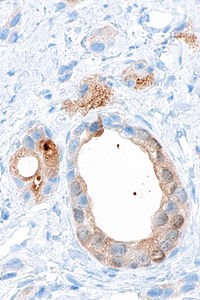Prostate-specific antigen
Jump to navigation
Jump to search
Prostate-specific antigen, abbreviated PSA, is marker that is quite specific for the prostate.
General
- Quantity in the serum used to screen for prostate cancer and follow patients with a history of prostate cancer.
- PSA immunostain useful for classifying a carcinoma as prostate carcinoma.
Serum PSA
- Normal - typically <= 4.0 ng/ml.
- Sensitivity: 82% (whites), 90% (blacks).[1]
- Specificity: 52% (whites), 38% (blacks).[1]
- Increases with age.[2]
Age-normal:
- 40s - 2.5 ng/ml.
- 50s - 3.5 ng/ml.
- 60s - 4.5 ng/ml.
- 70s - 6.5 ng/ml.
Note:
- The units for PSA may also be μg/L; note that 1 μg/L = 1 ng/ml.
Prostate-specific antigen density
- Abbreviated PSAD.
Normal is often considered to be: <0.15 ng/ml2.
- Approximately 8% of individuals below the cut-point (0.15 ng/ml) have medium or high-grade cancer.[3]
- In another series, 48% of individuals with cancer had a PSAD >0.15 ng/ml2.[4]
- Differences between races have been noted in one study; in those without prostate cancer:[1]
- 0.19 +/- 0.03 ng/ml2 (blacks).
- 0.11 +/- 0.01 ng/ml2 (whites).
PSAD is a better predictor than (unadjusted) serum PSA for:
- Gleason score upgrading on prostatectomy.[5]
- Benign prostate gland versus prostate cancer.[6][7]
A forumla for PSAD
Benson et al.:[6]
Where:
- .[8]
- H, W, L are the height, width and length.
An alternate estimation of the volume is:
- .
- D1, D2, D3 are the major axes.
Notes:
- The volume of an ellipsoid is:
- .
- As 1 cm3 is equal to 1 ml, the units of PSAD are (ng/ml)/cm3 or ng/ml2.
Immunostain
- Relatively specific for prostate
- May be found in normal pancreatic, salivary gland, Skene's glands and lactating breast tissue.
- In women, positive in up to 30-40% of breast cancers and also in tubulo-squamous polyps of the vagina.
Microscopic
Features - PSA immunostain:
- Granular cytoplasmic staining.
Notes:
- May be very weak -- need to look at high power.
See also
References
- ↑ 1.0 1.1 1.2 Henderson, RJ.; Eastham, JA.; Culkin, DJ.; Kattan, MW.; Whatley, T.; Mata, J.; Venable, D.; Sartor, O. (Jan 1997). "Prostate-specific antigen (PSA) and PSA density: racial differences in men without prostate cancer.". J Natl Cancer Inst 89 (2): 134-8. PMID 8998182.
- ↑ Ku JH, Ahn JO, Lee CH, et al. (September 2002). "Distribution of serum prostate-specific antigen in healthy Korean men: influence of ethnicity". Urology 60 (3): 475–9. PMID 12350489.
- ↑ Boulos, MT.; Rifkin, MD.; Ross, J. (Sep 2001). "Should prostate-specific antigen or prostate-specific antigen density be used as the determining factor when deciding which prostates should undergo biopsy during prostate ultrasound.". Ultrasound Q 17 (3): 177-80. PMID 12973074.
- ↑ Aganovic, D.; Prcic, A.; Kulovac, B.; Hadziosmanovic, O. (2012). "Influence of the prostate volume, prostate specific antigen density and number of biopsy samples on prostate cancer detection.". Med Arh 66 (1): 41-4. PMID 22482342.
- ↑ Sfoungaristos S, Katafigiotis I, Perimenis P (2013). "The role of PSA density to predict a pathological tumour upgrade between needle biopsy and radical prostatectomy for low risk clinical prostate cancer in the modified Gleason system era". Can Urol Assoc J 7 (11-12): E722–7. doi:10.5489/cuaj.374. PMC 3840515. PMID 24282465. https://www.ncbi.nlm.nih.gov/pmc/articles/PMC3840515/.
- ↑ 6.0 6.1 Benson MC, Whang IS, Pantuck A, et al. (March 1992). "Prostate specific antigen density: a means of distinguishing benign prostatic hypertrophy and prostate cancer". J. Urol. 147 (3 Pt 2): 815–6. PMID 1371554.
- ↑ Verma A, St Onge J, Dhillon K, Chorneyko A (June 2014). "PSA density improves prediction of prostate cancer". Can J Urol 21 (3): 7312–21. PMID 24978363.
- ↑ Eri, LM.; Thomassen, H.; Brennhovd, B.; Håheim, LL. (2002). "Accuracy and repeatability of prostate volume measurements by transrectal ultrasound.". Prostate Cancer Prostatic Dis 5 (4): 273-8. doi:10.1038/sj.pcan.4500568. PMID 12627211.
